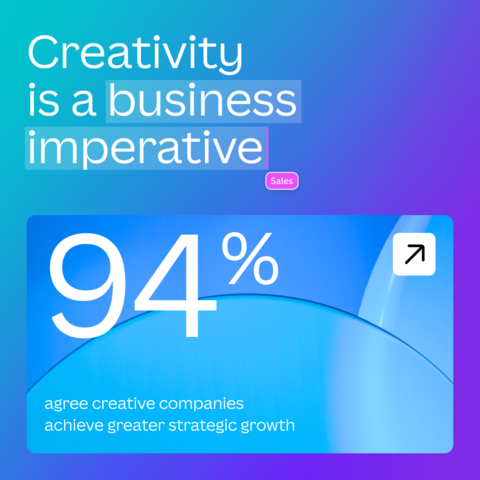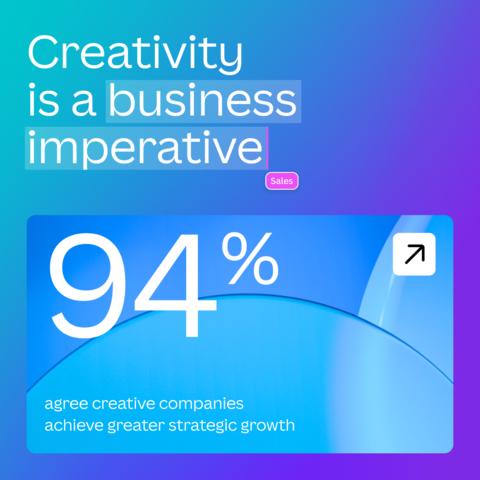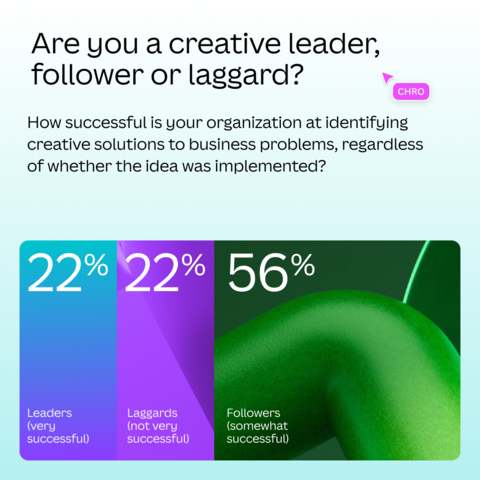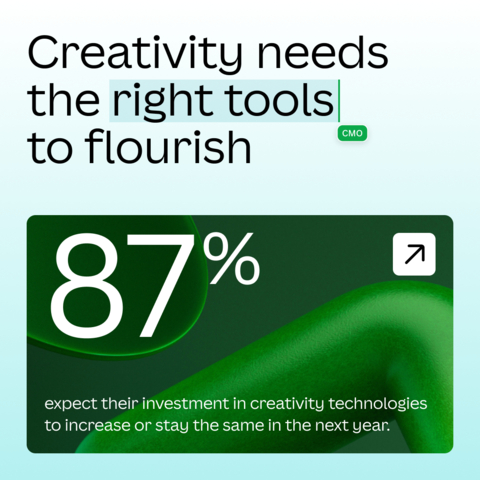SYDNEY--(BUSINESS WIRE)--Canva, the world’s only all-in-one visual communication platform, today unveiled insights from a study of more than 500 business professionals on the challenges of fostering creativity within the workplace.
Harvard Business Review Analytic Services conducted a global study in association with Canva and revealed that 96% of survey respondents agree creative ideas are essential to an organization’s long-term success and performance. In addition, 94% agree that organizations that invest in creative tools and technology will be more successful in the future.
However, while many acknowledge the importance of creativity and seek a creative edge, few are successfully converting innovative ideas into business impact.
Three categories of organizations emerged from the survey responses: leaders, followers, and laggards. These groupings were based on the organizations’ success at identifying creative solutions to business problems according to the respondents, regardless of whether the idea was implemented. Leaders (22%) are those organizations that are “very successful” at identifying and implementing creative solutions to business problems, while followers (56%) are “somewhat successful” and laggards (22%) are “not very successful.”
Top findings include:
- Workplaces are failing to nurture the creativity of their employees. Nine out of ten (91%) respondents agree that creative thinking is a key attribute for employees to possess yet more than half of laggards (58%) say their organizational culture doesn’t reward creative pursuits. Only 19% of leaders say the same.
Leaders (41%) are more likely than followers (17%) and laggards (8%) to encourage greater creativity by rewarding employees for taking creative risks and thinking outside the box.
-
Creativity must come from the top. Ninety-four percent agree that having a creative leader increases the creativity of their team. However, despite this widespread acknowledgment, nearly three-quarters of laggards (72%) say the leadership at their organization is not engaged enough in creative thinking to support creativity among employees. Among leaders, only 23% of respondents felt the same.
- Creativity needs the right tools to flourish. Ninety-four percent of respondents agree that organizations that invest in creative technology will be more successful in the future. Eighty-seven percent expect their organization’s overall financial investment in creativity-building tools and technologies to increase or stay the same in the next year.
Currently, the most used technologies to unlock creativity among leaders are collaboration platforms (65%), visual communication (64%), and data visualization tools (56%). Collaboration can enhance the creative process by tapping into new ideas, perspectives, and approaches. Leaders are significantly more likely than laggards to facilitate cross-functional collaboration (53% vs. 14%) and encourage different ways of thinking (52% vs.15%).
- Generative AI is helping organizations get ahead. Forty-two percent of leaders think gen AI can enhance creativity at their organization to a great extent. For example, according to leaders, gen AI may fuel creativity by: automating repetitive tasks, freeing employees up to focus on more creative endeavors (62%), accelerating idea generation (60%), and creating content with minimal human intervention (49%). While forty-seven percent of leaders are using gen AI tools to foster creativity for the purpose of strategic growth, only 30% of followers and 14% of laggards are doing so.
“In a business world focused on the bottom line, it’s easy to lose sight of the value of creativity. The findings highlight that creativity isn’t just a complement to business growth, it’s foundational to driving long-term success,” said Cameron Adams, co-founder and chief product officer, Canva. “Ultimately, innovation and creativity is what will differentiate the leaders from the laggards; it’s what drives growth in a challenging landscape.”
For a more extensive look at the survey findings, you can read the report here.
About Canva
Launched in 2013, Canva is a free online visual communications and collaboration platform with a mission to empower everyone in the world to design. Featuring a simple drag-and-drop user interface and a vast range of templates ranging from presentations, documents, websites, social media graphics, posters, apparel to videos, plus a huge library of fonts, stock photography, illustrations, video footage, and audio clips, anyone can take an idea and create something beautiful.
With a global community of more than 190 million monthly users, Canva is unlocking entirely new levels of creativity. Most recently, Canva introduced Canva Enterprise, a new offering to empower large organizations to easily create high-impact visual content and scale internal collaboration. This follows the release of Magic Studio, Canva’s AI-powered platform that consolidates the best AI design tools into a secure and easy-to-use platform.
Methodology
Harvard Business Review Analytic Services surveyed 542 members of the Harvard Business Review audience via an online survey fielded in November 2023. Respondents qualified to complete the survey if they were familiar with their organization’s approach to business strategy, problem solving, and innovation, and were knowledgeable about their organization’s approach to embracing creativity. Among the survey respondents 29% are in executive management or are board members, 31% are in senior management, 23% are in middle management, and 17% are in other grades.








